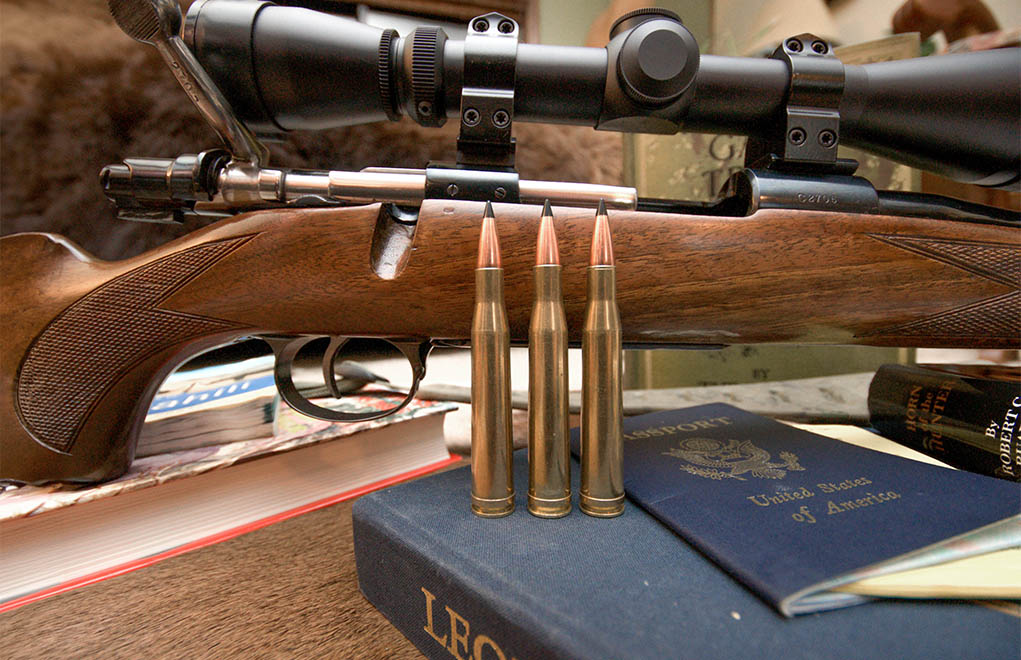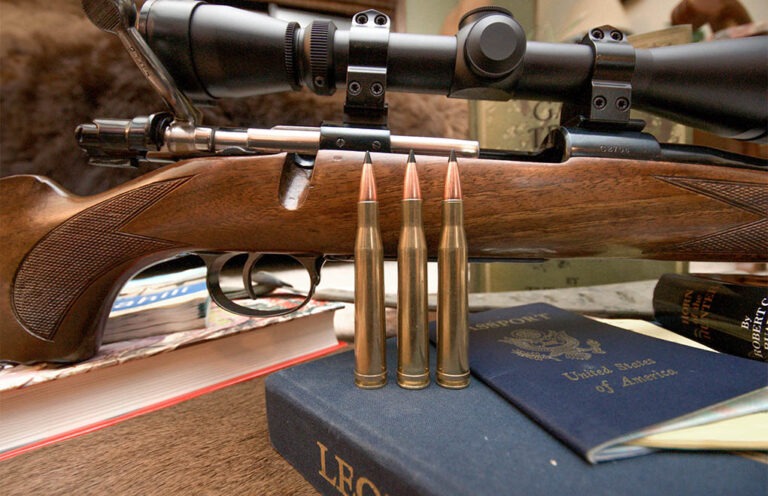
A closer look at .300 H&H Magnum, a cartridge that’s anything but old and in the way.
We tracked the herd of eland in nearly a full circle, working the wind to make sure our presence wouldn’t be detected. My guide—Professional Hunter Maré van der Merwe—spread the sticks in the fading light, offering me a quartering shot at the bull with impossibly long horns. I broke the trigger of the Colt Coltsman, and the resulting whine of a bullet told us both I’d missed.
“That bullet hit a branch, but that bull will come out to the right, just there.” Maré hadn’t finished the last word when the bull stood quartering at 340 yards, pausing just long enough to look back in our direction. The second bullet did not miss. It was the culmination of a great Namibian safari, and that bull’s horns taped over 38 inches.
That rifle’s barrel was marked simply: .300 MAGNUM. Produced in 1959, there was no commercially loaded .300 Magnum (the .300 Winchester Magnum wouldn’t hit scene for 4 more years) other than the .300 Holland & Holland Belted Magnum, known in other circles as the Super .30, but best known as here as the .300 H&H Magnum.
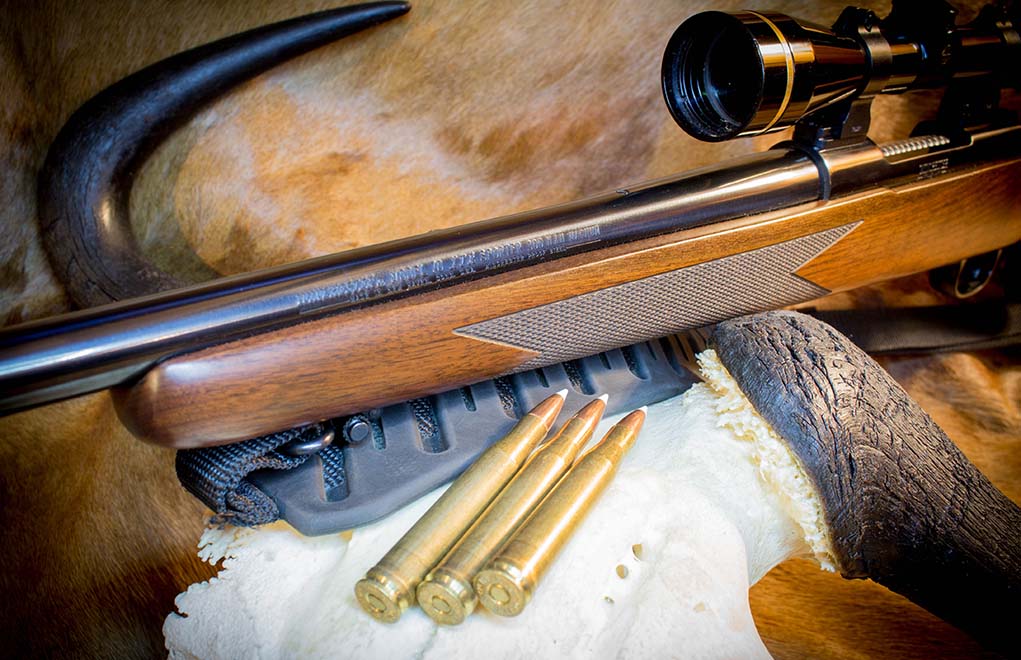
CIP (the Commission internationale permanente pour l’épreuve des armes à feu portatives) does recognize a slight dimensional variation between the .300 H&H Magnum and the Super 30, but I highly doubt you’ll be finding any Super 30 ammunition these days, so I wouldn’t be overly concerned about it.
The Family Tree
The .300 H&H was the fourth cartridge officially released by the London firm of Holland & Holland to feature a belt of brass just ahead of the extractor groove, following the .400/.375 (Velopex), the .375 H&H Magnum, and the .275 H&H Magnum, though all were preceded by the 41 Roper cartridge of the late 19th century. Where the .375 and .275 saw daylight in 1912, Holland’s Super 30 was released in 1925, “between the Wars” as they say.
Assuredly designed to take advantage of the huge success of the .30-06 Springfield—the military cartridge had, by then, long proved itself in the game fields—the .300 H&H Magnum would best the velocities generated by the American warhorse by 150 to 200 fps.
Like the .375 H&H that came before it, the .300 H&H came in two variants: belted and rimmed (though the United Kingdom will refer to this design as “flanged”), with the former being designed for the bolt-action repeating rifles, and the latter optimized for the single-shot and double rifles. The belted variety is, far and away, the most popular. While we’ll touch on the flanged cartridge in a bit, I’ll focus on the belted version.

Buckle Up
Sharing the same 0.532-inch case head diameter and 0.534-inch belt diameter as its more popular older brother, the .300 H&H maintains both the same case length (2.850 inches) and cartridge overall length (3.600 inches) as the .375 H&H. The slight 8½-degree shoulder gives a smooth and easy feel to both feeding and extraction, as headspace duties are neatly handled by the belt. That belt was, and remains, an excellent means of giving the definitive headspacing qualities of the rimmed cartridge designs, without any of the problems associated with stacking a rimmed cartridge in a box magazine or getting a rimmed cartridge to properly feed from that magazine style.
Most modern derivatives of the H&H case—such as the .300 Winchester Magnum, 7mm Remington Magnum, .338 Winchester Magnum and .300 Weatherby Magnum—still use the belt for headspacing, but a good many reloaders use the more prominent shoulder of these cartridges once they’ve been fired and resized. For the straight-walled cartridges like the .458 Winchester Magnum, .458 Lott and .470 Capstick, as well as those with a slight shoulder like the .300 H&H and .375 H&H, the belt is an aid (however, the .404 Jeffery and a handful of other cartridges make do with a shoulder of 8-10 degrees).
And in comparison to the .300 Winchester Magnum, which has been criticized for having a very short neck (0.264 inch), the .300 H&H Magnum offers plenty of neck tension, with its neck measuring 0.371 inch, well in excess of the desired one-caliber in length.
The length of the .300 H&H case is probably a derivative of the long, spaghetti-like structure of Cordite—the propellant so popular in Great Britain in the early 20th century—and how well that fit in the .375 H&H design. By 1925, if H&H weren’t already using stick powder, the transition wasn’t far off, but the case design stuck around.

The .300 H&H requires a magnum-length action, which has always been more expensive to produce and was historically offered in smaller numbers. Considering the speed race in the cartridge world was just building a head of steam—Winchester had released the radical .270 Winchester in the same year, in their Model 54 rifle—the .300 H&H’s velocity offered a respectable jump above the .300 Savage, .30-30 Winchester, 3-40 Krag and even the .30’06 Springfield.
And, of course, then as it is now, there is the exotic factor: In comparison to the majority of the American cartridges, the .300 H&H just looked plain ol’ cool.
In the Wild and at the Range
The .300 H&H quickly garnered a great reputation among those headed to Africa and India. John “Pondoro” Taylor wrote in his excellent African Rifles and Cartridges, “Everything the .30-06 will do is done better by the .300 Magnum—as is only to be expected.” Pondoro would go on to opine that India offered the longest shooting in the (then) British Empire, indicating an appreciation for the .300’s flat trajectory on a number of the Himalayan species, but equally approving of the 220- and 225-grain loads offered by Peters and Remington, respectively.
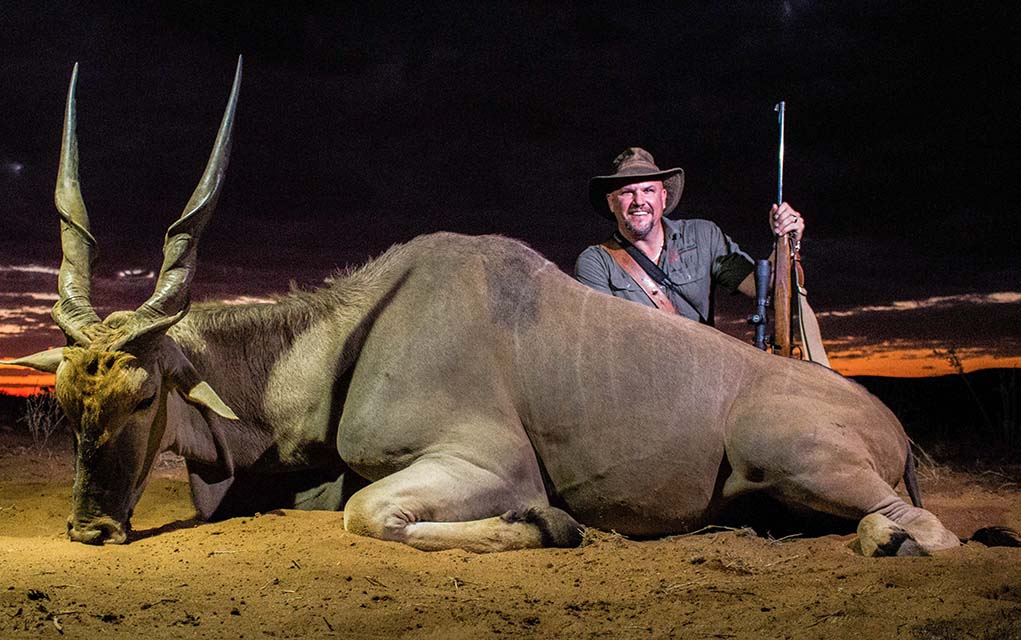
And therein lies the rub: One of the biggest factors in the successes of the .375 and .300 H&H Magnum cartridges was not necessarily the British rifles and ammunition, but the fact that the American rifle and ammunition manufacturers embraced them both. The pair was among the initial offerings in Winchester’s excellent Model 70—released in 1936—and ammunition for both was readily available.
This fact also explains why the .375 H&H became the go-to cartridge for traveling sportsmen headed to the Dark Continent: Not only is it effective in its own right, but American rifles and ammunition were made long after the British stuff began drying up.
Simply put, a great British cartridge was put into American mass production.
But it wasn’t only the Eastern Hemisphere where the .300 H&H showed its potential; here in North America, Ben C. Comfort used the cartridge to win the Wimbledon Cup in 1935, with a Griffin & Howe rifle based on a Remington 30S action. The .300 H&H also played a big role in the development of the premium bullet market, as John Nosler carried one on the fateful Canadian moose hunt where his projectiles failed to penetrate on a mud-caked bull. And it was the case upon which Roy Weatherby would base his lineup of speedy cartridges, cementing his place in firearms history. American author Robert Ruark would also go on to use the .300 H&H as the rifle choice for his fictional Professional Hunter Brain McDermott in his gripping Uhuru.

I believe that despite many sparks in the early 20th century, the .300 H&H Magnum is the point where the speed game actually caught fire. Unlike Savage’s .250-3000, the .300 H&H Magnum has the bullet weight to be a true all-around big-game cartridge, and is versatile enough to be taken around the globe. It’ll push a 180-grain bullet to a muzzle velocity of 2,875 fps in factory loads, making it “enough gun” for the vast majority of big game pursued, including the great bears of the north and all but the largest and most dangerous game of Africa.
I’ve owned two rifles chambered for this excellent cartridge: the aforementioned Colt Coltsman that accompanied me to Namibia (and is now in the possession of a dear friend), and currently a post-64 Winchester Model 70 from the early ’80s, with one of the prettiest factory walnut stocks I’ve ever seen.
The M70 shows a preference for longer projectiles, with more bearing surface; this is contradictory to my experiences handloading for more than a few .300 H&H rifles. Generally speaking, the .300 Holland is one of the few .300 Magnums that doesn’t mind the light-for-caliber projectiles, but my own gives the best accuracy with the 180- and 200-grain projectiles, and I’m OK with that. The Federal 180-Trophy Bonded Tip load and Nosler’s 200-grain AccuBond load were among the top performers in this rifle; either of those bullets would handle just about anything I’d ask a .300 Magnum to do. With a 200-yard zero, you’ll see these bullets strike about 7 inches low at 300 yards and roughly 22 inches low at 400 yards.
In comparison to other .30-calibers, I feel the .300 H&H Magnum does better the performance than that of the 30-06 Springfield, though perhaps not enough that the average hunter would truly take notice. It is a bit slower than the .300 Winchester Magnum and .300 Winchester Short Magnum, and certainly slower than the .300 Weatherby Magnum and .300 PRC. But the .300 H&H is probably the easiest on the shoulder of all the .300 Magnums. And in the hands of good reloader, it can be brought down to .30-06 or even .308 Winchester velocities without too much trouble, making it a great choice for deer on the back forty, or it can be revved up to nip at the heels of the .300 Winchester Magnum, which is a good place to be as well.
Is it efficient? In comparison to the .300 WSM and .300 Winchester Magnum—which can deliver slightly better ballistics in a short-action and long-action rifle, respectively—probably not. But shooting a .300 H&H Magnum isn’t about the ultimate in efficiency; it has its own pedigree, and well, a cool factor to it. It’s an inexorable tie to a time long gone now, invoking the sentiments of safari in wild places, or long treks into the wilds of Canada, Alaska or those remote parts of the American West. I feel pretty confident saying that the belted cases—while they are not going away anytime soon—have seen their day, and we probably won’t see any new cartridges featuring the H&H belt anytime soon. However, the .300 H&H Magnum remains cooler than the other side of the pillow, at least to my eyes.
Ammunition Availability
Yes, there’s an elephant in the room: The glaring fact of the matter is that the .300 H&H has been pushed off the stage by newer, more efficient and better marketed .30-caliber cartridges. Each year, rifles and ammunition become increasingly scarce, and it will be just a matter of time before handloading is the only means of keeping the old girl alive. In fact, as of the time of this writing, the only factory loaded ammunition even cataloged is listed as “unavailable,” with no production information available. So if you want the .300 Holland experience, you either find older stashes of ammunition or handload your own.
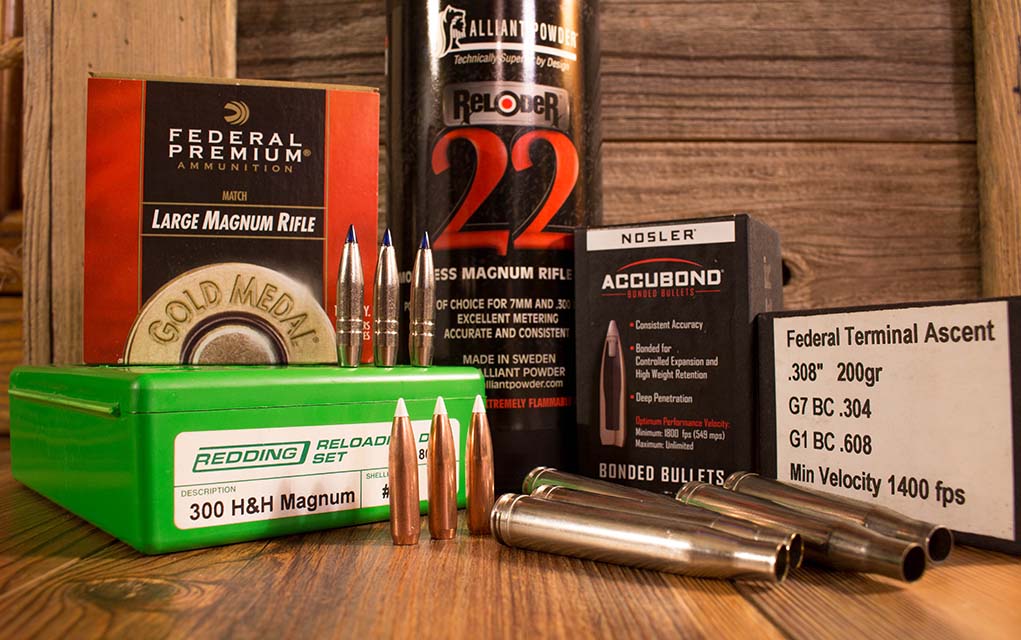
Get a good set of dies—Redding dies are my favorite—and a good supply of brass, and you’ll be in business for life. I like Norma brass, and I like Nosler brass as well, though the situation with the .300 H&H is quickly becoming “any port in a storm.” But given my druthers, it’s Norma and Nosler for me, and I’ll happily take Federal or Hornady.
The powder charges of the .300 H&H Magnum warrant the use of a large rifle magnum primer; my favorite is the Federal Gold Medal Match GM215M. Powders in the range of IMR 4350 and 4831, Reloder 19 and 22, Hodgdon’s H4350, H380 and H4831SC are all good choices; the .300 Holland likes powders in the slow-but-not-too-slow department. My experiences show that charges that nearly fill the case give the most uniform results.
Good ol’ round and heavy bullets, like the Hornady 220-grain round-nose Interlock, are just as good as they were a century ago, especially at closer ranges; don’t overlook them for larger species in a woods or bushveld situation.
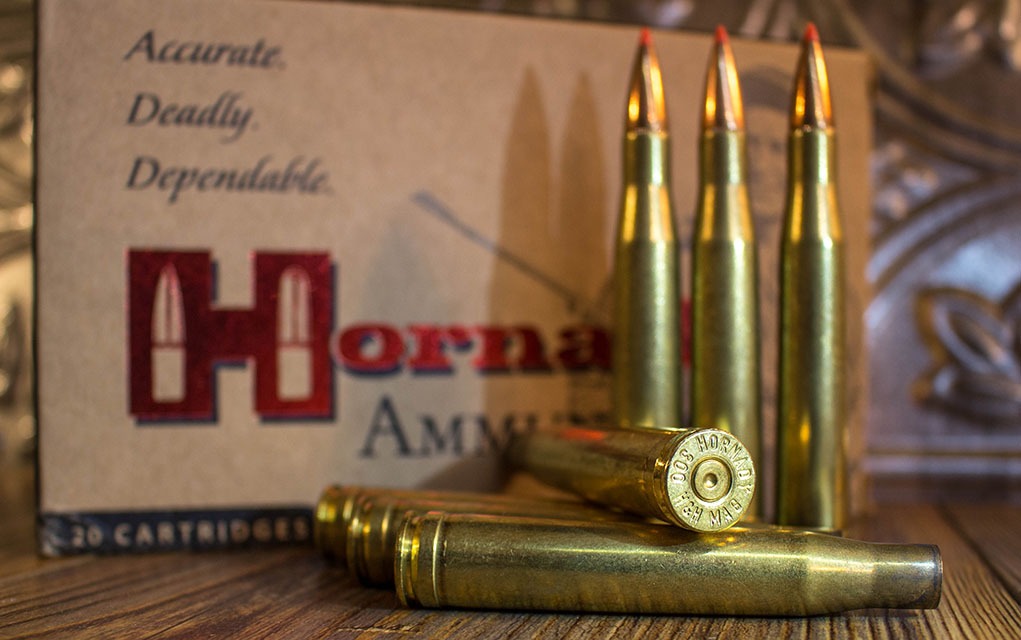
I’ve championed a number of relatively obscure cartridges over the years, with some being on the verge of extinction. The .318 Westley Richards, .404 Jeffery and .33 Winchester each were at one point in time a sound choice with a decent following. Will we be seeing any new developments for the .300 Holland & Holland anytime soon? Sadly, I doubt it—though there are enough rifles out there chambered for it that perhaps Hornady or Federal will make another run of quality factory ammunition.
If you enjoy hunting with a cartridge that’s a bit left of center, and something that will cock an eyebrow or two in hunting camp, you could do worse than choosing the .300 H&H Magnum. In the meantime, I’ll invest my time at the reloading bench to keep my Winchester properly fed.
Editor’s Note: This article originally appeared in the July 2024 issue of Gun Digest the Magazine.
Raise Your Ammo IQ:

Next Step: Get your FREE Printable Target Pack
Enhance your shooting precision with our 62 MOA Targets, perfect for rifles and handguns. Crafted in collaboration with Storm Tactical for accuracy and versatility.
Subscribe to the Gun Digest email newsletter and get your downloadable target pack sent straight to your inbox. Stay updated with the latest firearms info in the industry.
